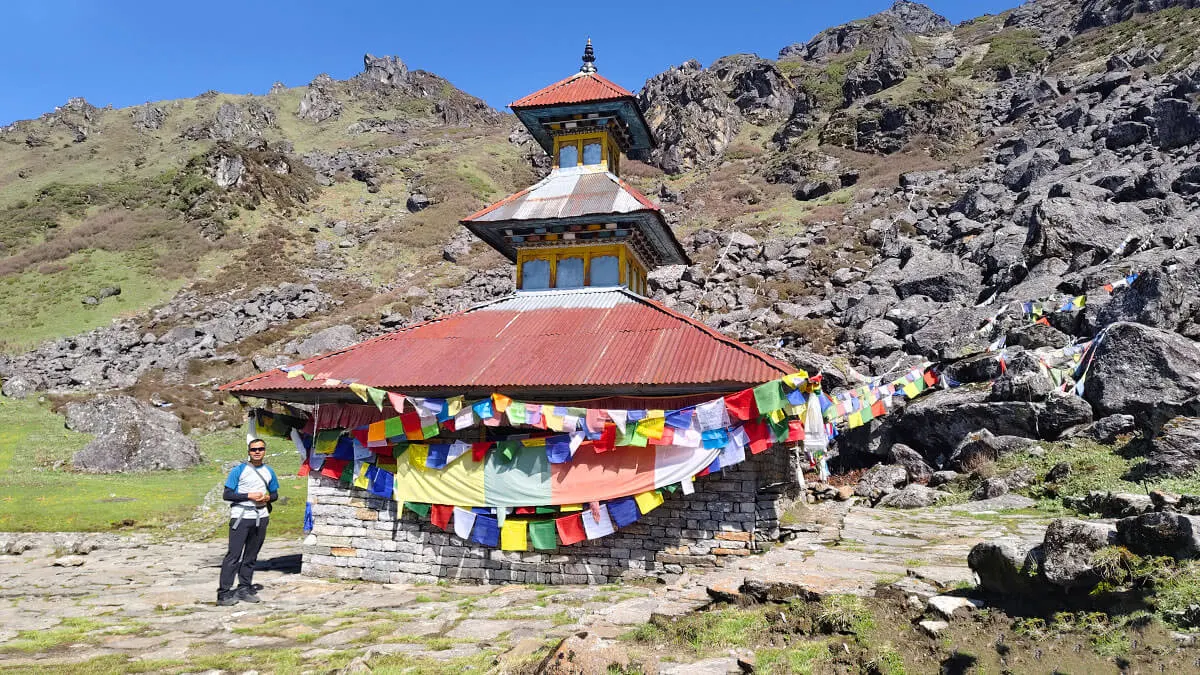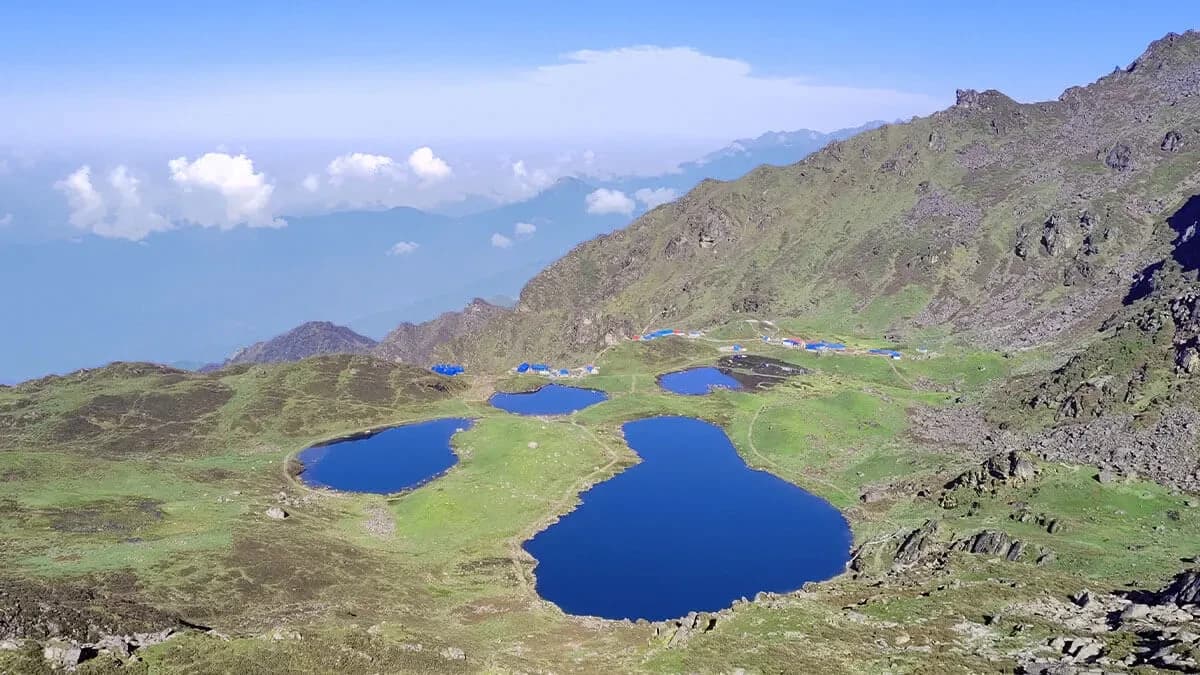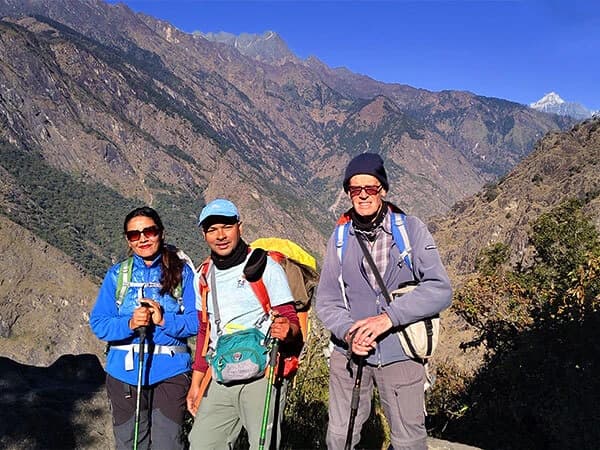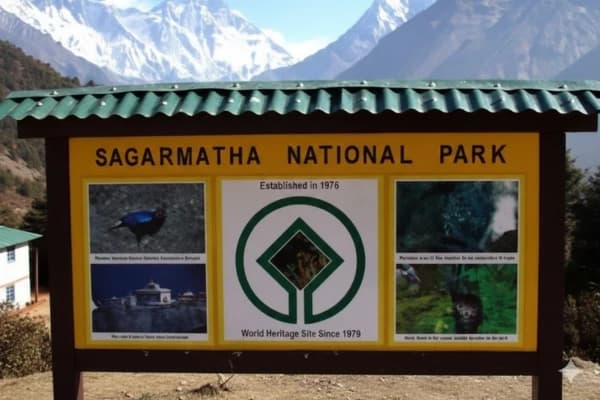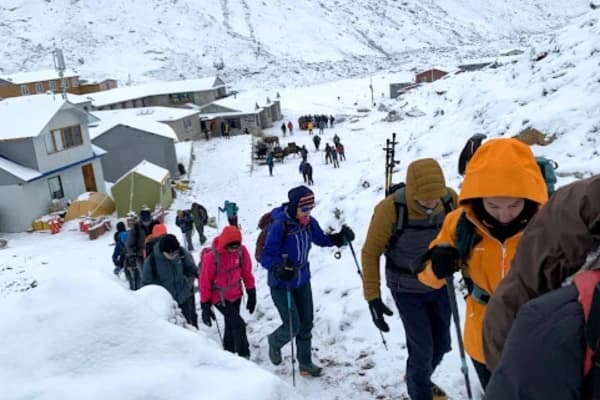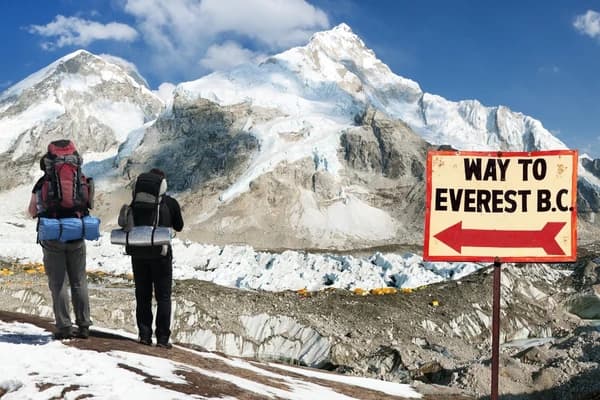Nestled deep within the Langtang National Park in Nepal's Sindhupalchok district lies a sacred destination of serenity and beauty: Panch Pokhari, or the "Five Lakes." I embarked on this off-season trek solo, driven by curiosity, spirituality, and a thirst for adventure.
The Panch Pokhari Trek offers a unique charm regardless of the season. While some trekkers prefer the lushness of monsoon, winter presents its own beautiful, albeit more challenging, landscape. Even though I trekked during the pre-monsoon, an off-season for many trekking areas, what I found was far beyond my expectations. I was greeted to a stunning view of the five holy ponds, surrounded by snow-capped peaks, from the viewpoint at 4,300 meters. The view was breathtaking, with majestic mountains rising directly behind me.
This guide provides a comprehensive, unvarnished representation of Panch Pokhari's scenery, culture, and spirit. To find the whole schedule, a breakdown of the costs, and the essential suggestions I'll provide you along the way, make sure to read all the way through.
![view from deurali including Ama yangri peak in helambu [Click and drag to move] ](https://media.app.nepalgatewaytrekking.com/uploads/media/blog-photo/off%20the%20beaten%20path%20trek/landscape-view-in-clear-day.webp)
Why Trek to Panch Pokhari?
Majestic Landscapes: The Panch Pokhari region is renowned for its pristine natural beauty, offering panoramic views of the Langtang, Jugal Himal, and Rolwaling ranges. The serene lakes, lush green meadows, and vibrant rhododendron forests create a truly picturesque landscape. These sites are also important pilgrimage destinations for both Hindus and Buddhists. This trek remains relatively off-the-beaten-path compared to more commercial treks like Everest Base Camp or Annapurna Circuit, allowing you to enjoy a peaceful journey away from large crowds.
Sacred Site: Panch Pokhari is considered a sacred site for both Hindus and Buddhists, drawing numerous pilgrims seeking spiritual solace.
Janai Purnima Festival: The Janai Purnima festival in August is a notable event where devotees bathe in the holy ponds, believing it will cleanse their sins.
Mythological Roots: According to Hindu mythology, the five lakes were created by Lord Shiva, who bathed in them after consuming poison to save the universe. It's also believed that Lord Shiva dug the water at Gosaikunda with his trident (often depicted as a sword in some narratives) to quench his thirst. On the August full moon day (Janai Purnima), a large number of devotees visit Gosaikunda Lake for worship.
Spiritual Peace: Beyond the myths, the lakes are a source of spiritual peace and meditation, adding a profound dimension to the trek. The sight of the five ponds, surrounded by snow-capped peaks, is simply awe-inspiring.
Untouched Trails: Unlike Everest or Annapurna, this trail offers solitude and authenticity.
Local Hospitality: Encounter Tamang communities, simple teahouses, and soulful interactions.
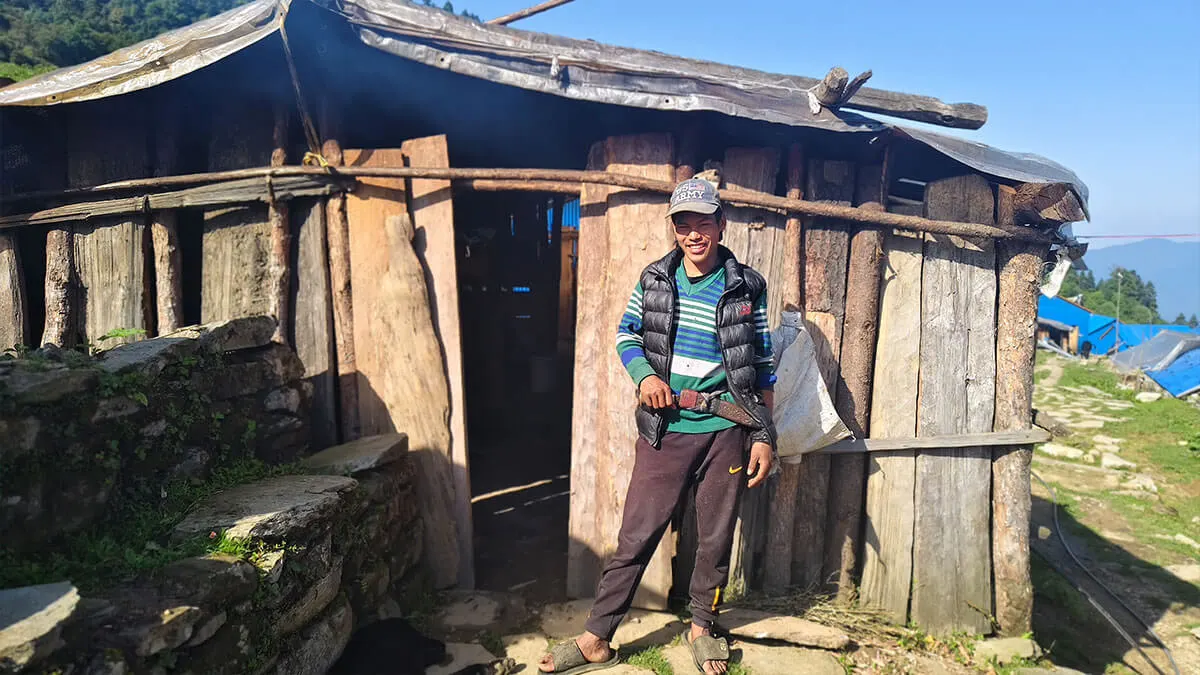
Key Facts About Panch Pokhari Trek
- Region: Langtang National Park, Sindhupalchowk District, Bagmati Province
- Max. Altitude: 4,300 m (Viewpoint)
- Trip Duration: 4 days (can be done in 3 days with a faster pace or with your own vehicle)
- Trek Duration: 3 days
- Trek Difficulty: Moderate to Challenging
- Network Availability: Limited to Tuppi Danda, Nosyampaati, and Viewpoint.
- Charging Availability: Solar / Generator (evening time only)
- Best Time to Visit: Throughout the year (with varying attractions)
For Nepalese: Free of cost (note: there's a plan to charge for National Park entry in the coming years).
For Tourists: Langtang National Park Permit & TIMS Card (I'll cover these in detail in another guide).
Arriving at Panch Pokhari-Thangpal Rural Municipality in Sindhupalchowk is the first stage of your Panch Pokhari Trek. There are currently no direct buses from other regions of the country, so if you're coming from somewhere else, make sure you get to Kathmandu first (unless you can manage to reach Melamchi).
Note: You can drive a two-wheeler or a four-wheeler up to Dukhang Kharka (just past Deurali) if you intend to travel to Chhimti in a private car. Drive carefully, though, as the road conditions aren't the best!
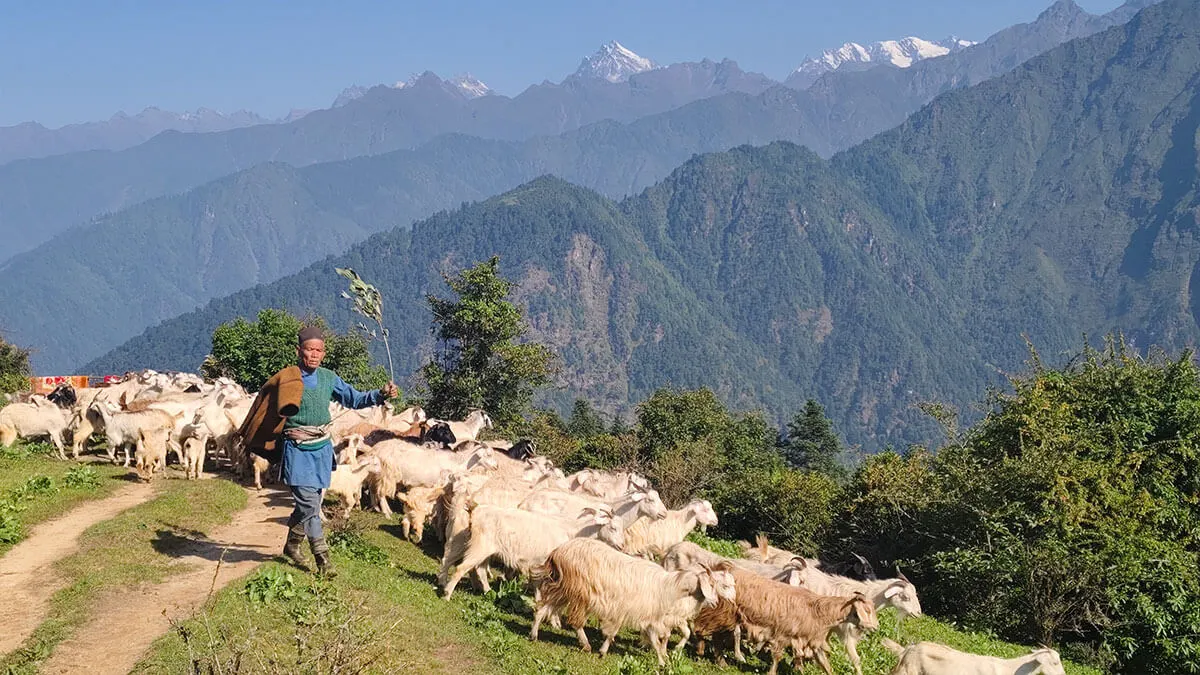
Panch Pokhari Itinerary- 4 Days
Although my solo pre-monsoon trek to Panch Pokhari presented a challenge with unexpected rainfall, it was nonetheless an unforgettable journey. For those with limited time and favourable conditions, a 2-night, 3-day trip is feasible. However, as altitude sickness is a constant consideration, a more measured approach is often advisable.
This guide details my recommended 3-night, 4-day itinerary, which I found to be the shortest, easiest, most comfortable, and most budget-friendly way to experience Panch Pokhari. Let's begin!
1: Drive from Kathmandu to Chhimti/ Bhotang (1800m) and Trek to Tuppi Danda (2400m)-6 hours of driving and 4 hours of trekking.
The bus departs from Jorpati (1,330 m) and follows the Sankhu-Melamchi road. It then continues to Thangaldhap and finally reaches Bhotang. The bus quick stop at the Melamchi (850 m) for snacks and a toilet break, and within 5-6 hours, you should reach the starting point of the Panch Pokhari Trek, Chhimti (1,800 m) for lunch.
You can take the same path whether you're riding a motorbike or any other type of private car. Leave Chhimti and continue to Deurali (2,000 m) and then to Dukhang Kharka (2,100 m). For those arriving in Chhimti by bus, have your lunch at one of the nearby hotels then begin the walk to Deurali and Dukhang Kharka. You'll notice bikes parked in this area.
Next, continue towards Tuppi Danda, you might only make it to Tuppi Danda or perhaps Tangu Kharka (2,878 m) on this day if you're taking a later bus or have to hike from a farther distance. So, think about booking a room at one of these places. After 3 to 4 hours of hiking on the first day, the teahouse at your destination should provide just enough comfort for a restful night's sleep.
Travel Facts for Day 1
Speciality: Bhotang and Chhimti Village, Raithane Pokhari, Waterfalls, River, Suspension Bridge, and lush green forest.
Accommodation Type: Teahouse Lodge (private room or basic dormitory)
Teahouse Lodge Contacts
- Tungna hotel and lodge: 9866285760 / 9863553215 (for Deurali)
- Brongdogang Tupidanda Homestay: 9863548829/ 9860563345
- Kale Tamang : 9847309570
Note: To make your second day of trekking easier, I recommend continuing your journey beyond Tuppi Danda. Consider extending your trek by an additional 30 minutes to 2 hours to reach either Tangu Khola (or Rato Mato).
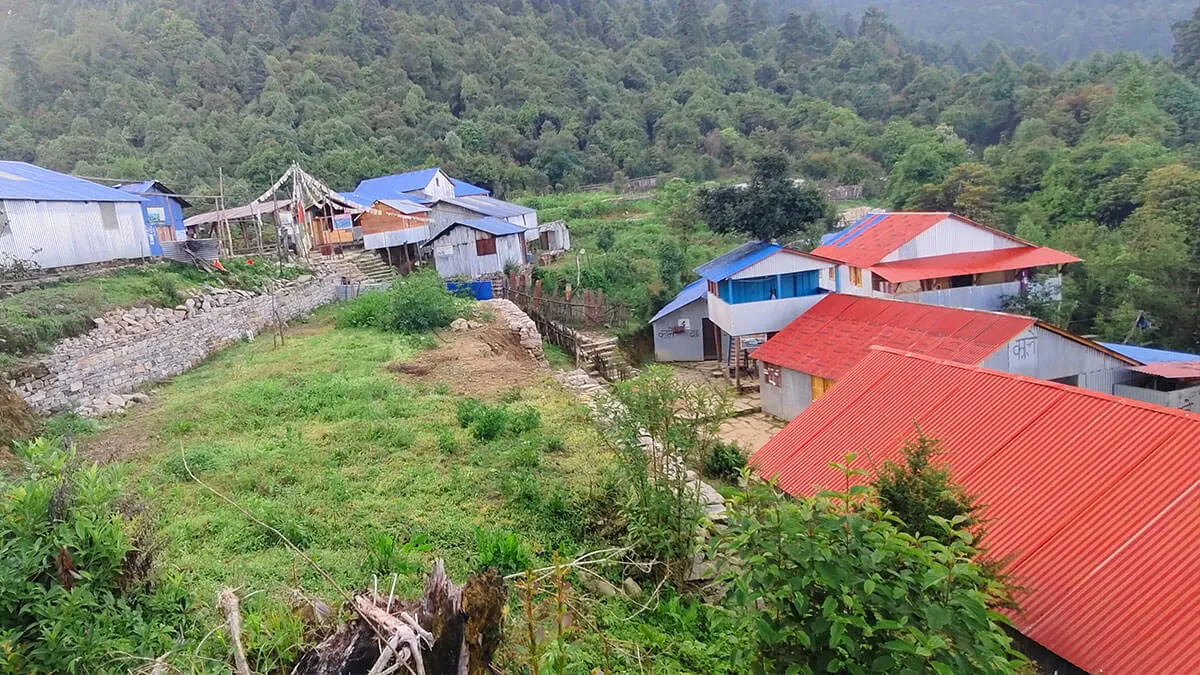
Day 2: Tuppi Danda to Panch Pokhari (4100m), 7 to 8 hours trekking
After breakfast (chana, boiled eggs, and black coffee), the trek starts through dense forest, crossing Tangu Khola (2,893 m), and climbing comfortably up to Rato Mato (2,950 m). While the first day's trek was relatively easy, the second day presents more challenges. Before beginning your walk, make sure you eat an enormous breakfast.
Head towards Chokar Danda (3,100 m), then continue to Tap Kharka and finally Nosyam Pati (3,661 m). You can stop here for a lunch break. Proceed to Saat Ghumti (3,800 m), where the true struggle starts. The path is narrow, and the upward climb can be challenging, especially for newbies. The hardest part is probably the steep climb to Lauribina.
The fact that everything was coated in snow and that even the side rail in the higher area had collapsed made it especially challenging for me. The route gets much easier once you cross Lauribina. Continue in the direction of Mani, and you will soon arrive at Panch Pokhari (4,100 m).
It took me approximately 7 hours to reach Panchpokhari from Tupidanda. The walking duration depends on your pace, prior experience, and trail conditions, so it may take up to 8/9 hours. You can even go to the Viewpoint that same day if you get there early. Nevertheless, keep in mind that Panch Pokhari's weather can be unpredictable.
I chose to stay at Panch Pokhari itself because I was by myself and had to put my safety first, particularly given the possibility of altitude sickness. Honestly, this is probably the best option for all of you. You'll be able to learn about the area more thoroughly in this way: As soon as you leave your lodging, y you will come across the Bumba Ruwa Waiba Memorial, which honours the individual who discovered the five ponds.
Travel Facts for Day 2
Speciality: Beautiful landscapes, wildflowers, waterfalls, and Panch Pokhari
Accommodation Type: Mountain Lodge / Tent
Hotel/Lodge Contacts for Nosyampaati & Panch Pokhari
- Nosyampaati Homestay and Lodge: 9848921440, 9741392660 (also for lunch)
- Panchpokhari Bhim Arjun Shankar Hotel and Lodge: 9863548196 (Bhim Tamang, Arjun Tamang)
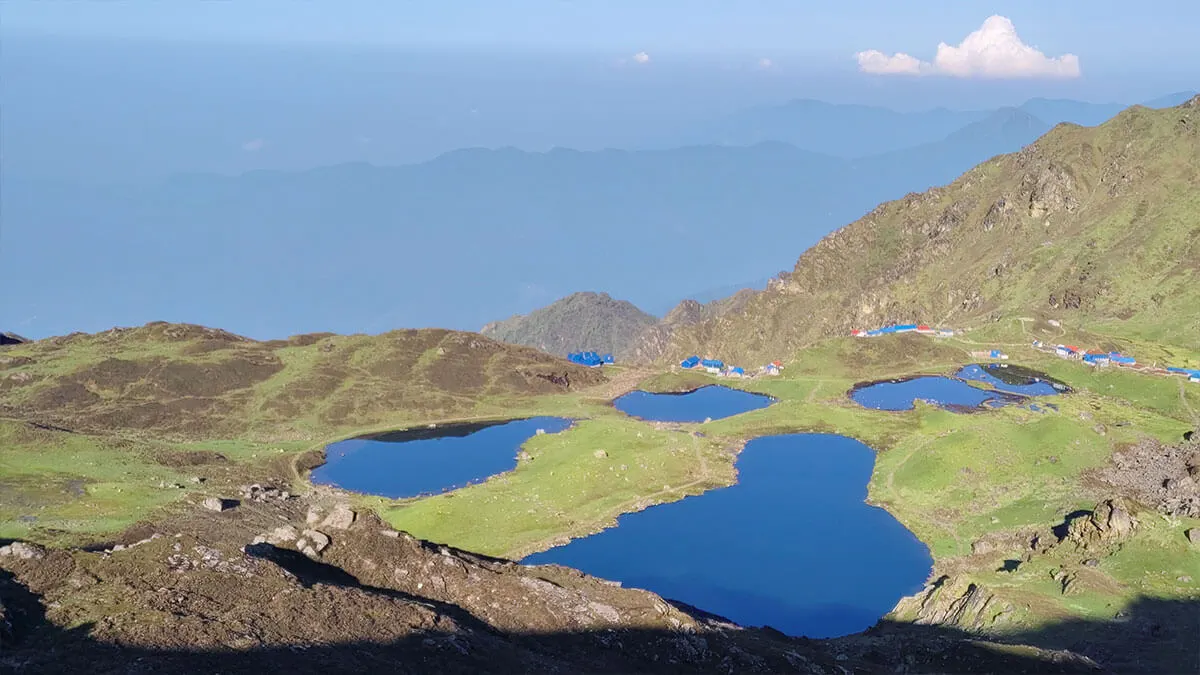
The view from the Panch Pokhari viewpoint, a set of five holy lakes.
Day 3: Panch Pokhari to Viewpoint (4300m) and back to Chhimti, 8 to 10 hours trek. Elevation Descent: 2500m
On this day, you must wake up as early as possible. My suggestion? Start your hike before sunrise. I had missed a stunning sunrise over the Jugal Himal range and the surrounding mountains. Don't make the same mistake!
Consider yourself fortunate if you hiked to the Viewpoint (Furkemani Danda) the day before. You won't have to put in additional effort to take in the captivating scenery.
It takes roughly 35 minutes to an hour to trek to the Panch Pokhari Viewpoint (4,300 m). The five sacred ponds are breathtakingly visible from this location. This is the scene you've come for, whether it's snowing or covered with flowers!
At the viewpoint, there is a little cottage where you can have breakfast or a cup of tea while taking in the expansive views of the Jugal Himal range, Langtang Lirung (7,234 m), Dorje Lakpa (6,966 m), Gaurishankar (7,134 m), and other Tibetan Himalayan peaks. It takes roughly 20 to 30 minutes to walk back.
The return hike takes about 20 to 30 minutes. But before heading back to your lodge, make sure to visit all the remaining ponds you may have missed the previous day—Surya Kunda, Ganesh Kunda, and Naag Kunda.
After collecting your belongings, begin your descent to Chhimti via the same trail. You can stop at Nosyam Pati for lunch, or if you have snacks with you, make use of them (just like I did).
Before concluding your Panch Pokhari adventure tour, you will spend the night in Chhimti, which should take roughly 7 to 8 hours to get there.
Travel Facts for Day 3
Specialty: Jugal Mountain range, panoramic view of Panch Pokhari, beautiful landscapes, wildflowers.
Accommodation Type: Guest House / Hotel (in Chhimti or nearby)
Hotel/Lodge Contacts (for overnight stay options on descent)
- Nosyampaati Homestay and Lodge: 9848921440, 9741392660
- Panchpokhari Bhim Arjun Shankar Hotel and Lodge: 9863548196-Bhim Tamang, Arjun Tamang- 9848933271

Beautiful views of snow-capped peaks, including Dorje Lakpa, Madiya, and Phurbi Chhyachu, are seen from the Panch Pokhari viewpoint.
Day 4: Drive Chhimti to Kathmandu, 6 to 7 hours
Bus Timing: 8:00 AM (preferred), 1:00 PM
Speciality: Chhimti Waterfall, Gunsa (Beautiful Tamang Community Village), Indrawati River sides.
Drive Duration: 6 to 7 hours
Bus Timing: 8:00 AM, 1:00 PM
The hotel where you are staying can easily arrange for your bus tickets to Kathmandu, as they frequently handle reservations. Usually, the bus leaves from Chhimti, but if the roads are bad, you might have to go a little way to Bhotang to catch it. So, be mentally prepared for this possibility.
I suggest you board the first bus that comes up, just like you did on Day 1. I took a bus back at 8 AM, but if you're lucky, you could get one at 6 AM. The bus stops at Melamchi for lunch. It will take approximately 6 to 7 hours to travel to Jorpati, Kathmandu.
If you can’t descend one day, you can stay at Tupidanda, and the next day you can catch a 1 pm bus to Kathmandu.
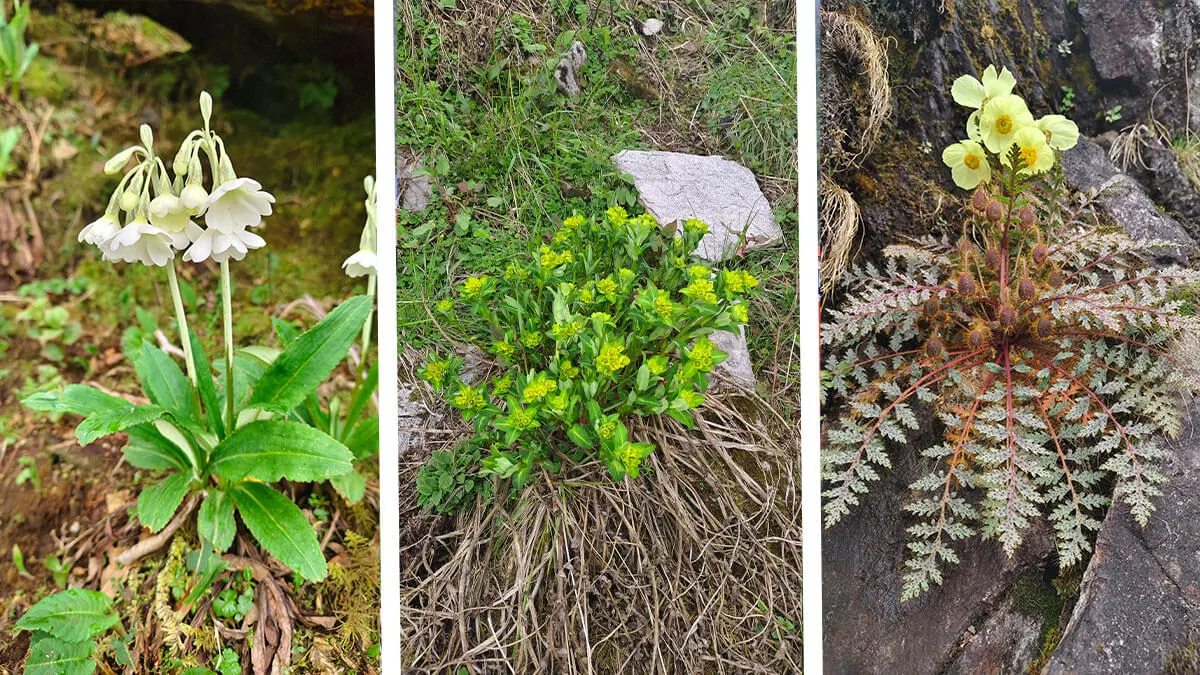
Best Time and Season to Visit Panch Pokhari
| Season | Months | Attractions |
| Spring | March to May | Blooming rhododendrons, clear mountain views |
| Monsoon | June to August | Vibrant greenery, occasional rain challenges |
| Autumn | September to November | Crisp air, stunning mountain views |
| Winter | December to February | Snow-covered landscapes, extreme cold, and more challenging |
My solo trek to Panch Pokhari in June 2025 was a pre-monsoon experience. I arrived just in time for late spring, when alpine flowers were starting to bloom, and mountain goats, yaks, and Zho were enjoying the alpine meadows.
If you're drawn to nature, the monsoon season offers lush greenery and a variety of flowers, though mountain views may be obscured by rain and fog. The Janai Purnima festival brings a vibrant crowd to Panch Pokhari and the Shiva Temple, making it the best time for a cultural experience.
For the best of both worlds (flowers in bloom and clear mountain vistas), late spring and early autumn are generally the best times to visit.
How Difficult Is It to Find Accommodation in Panch Pokhari?
Accommodation in Panch Pokhari isn't hard to find. The trekking committee ensures that at least one hotel remains open every 2–3 hours of walking distance, especially in the off-season.
During peak seasons, particularly Janai Purnima, all hotels operate, but expect heavy crowds. Many trekkers even opt to set up tents. You'll find accommodation at all major points along the Panch Pokhari trail: Chhimti, Deurali, Dukhang Kharka, Tuppi Danda, Tangu Kharka, Rato Mato, Chokhar Danda, Tap Kharka, Nosyam Pati, Panch Pokhari, and the Viewpoint (Furkemani Danda).
However, in the off-season, hotels typically remain open only at Rato Mato, Nosyam Pati, Panch Pokhari, and the Viewpoint. This can change, so it's always good to be flexible with your plans.
Try your next adventure to Tsho Rolpa trek, it offers stunning Himalayan views & a pristine glacial lake. Experience Sherpa culture on this unforgettable journey.
Kathmandu to Chhimti Bus Details
- Bus Service Provider: Ama Yangri Hyolmo Yatayat, Samyukya Ticket Counter (Shiva Chok)
- Location: Shiva Chowk, Jorpati, Kathmandu
- Contact Details: 01-5223131/ 9741894408 (counter staff)
- Bus Fare: Rs. 650
- Bus Timing: 6:20 AM (recommended), 8:20 AM, 11:00 AM
- Final Destination: Chhimti / Bhotang
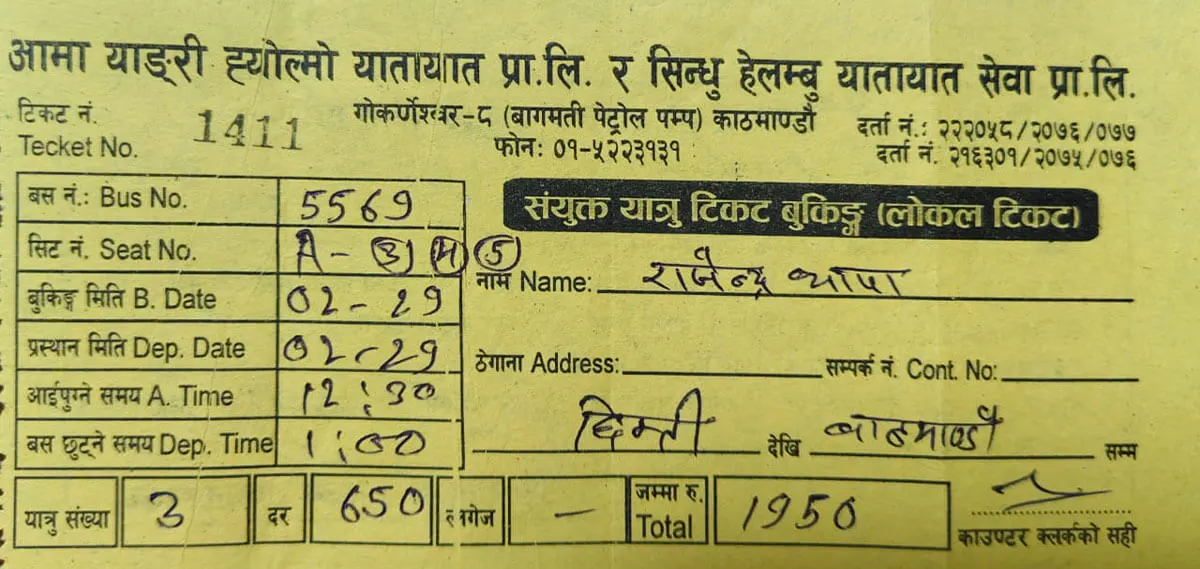
Bus ticket from/to Chhimti / Bhotang
Cost Breakdown of Panch Pokhari Trek
For your Panch Pokhari Trek, you should budget around NPR 6,000 to 7,000 per person for a standard trip. This is a budget-friendly estimate, so if you prefer more comfort or flexibility, expect to spend a bit more. If you're a foreign tourist, the cost will be significantly higher due to permit fees, potentially higher hotel charges, and additional services for a more comfortable experience.
Final Words
Now that you have a complete guide to the Panch Pokhari trek, share this article with your travel buddies and start planning your adventure!
While I originally planned to include a packing list, I'll leave that to you. Just remember to pack light and don't forget a raincoat, warm clothes (regardless of weather), headlamp/torch, necessary medicines, light snacks, a power bank, and crampons (if trekking in winter, as the trail can get icy).
While a solo trek to Panch Pokhari is certainly possible (as I did), stay very cautious. Always check the trail conditions beforehand. If you have any questions, feel free to ask in the comments below!
Happy trekking to Panch Pokhari!
